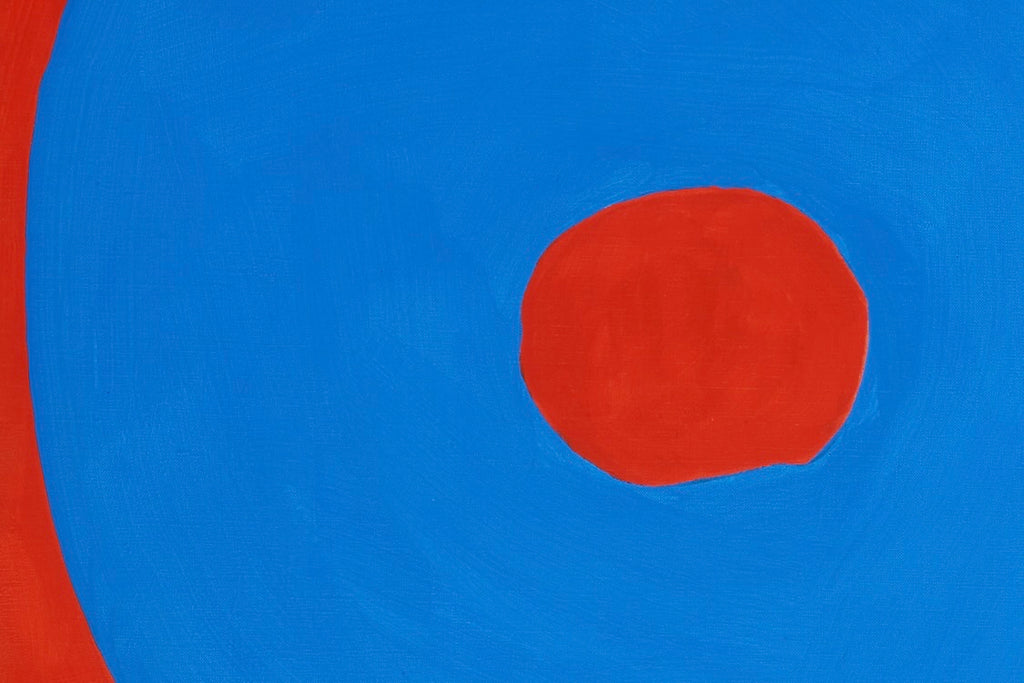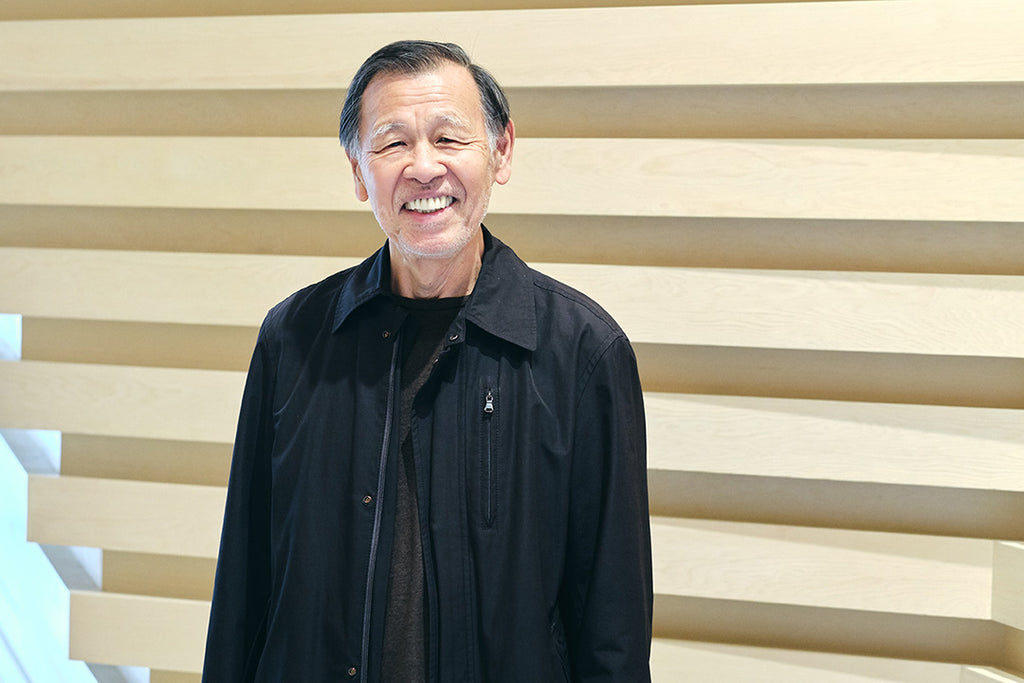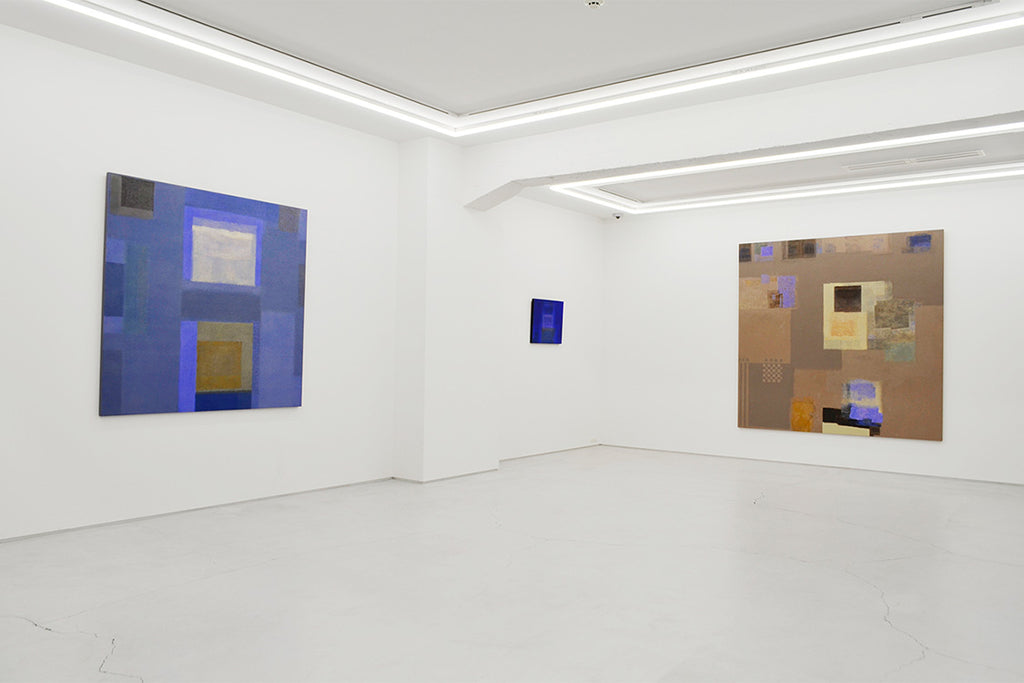ARTICLES
Being Gutai Is All About Myself
A New Appreciation Contemporary Japanese and Asian Art
20/23

“TSUYOSHI MAEKAWA: The Strength of Matter” Whitestone Gallery Taipei, 2017
In our ongoing series, we present the digital archive of the book 'A New Appreciation Contemporary Japanese and Asian Art' This book delves into internationally acclaimed artists and the dynamics of the Asian art market. The twelfth installment features artist Tsuyoshi Maekawa and art critic Kunio Motoe.
Being Gutai Is All About Myself|Interviews of Experts in the Art Industry
Tsuyoshi Maekawa
Artist
Kunio Motoe
Professor Emeritus, Tama Art University, Art Critic
Gutai is receiving attention again lately. As museums within and beyond Japan introduce Gutai artists, their works are being sold at high prices in auctions. Pioneer artists like Jiro Yoshihara, Kazuo Shiraga, Atsuko Tanaka, and Chiyu Uemae have already passed away, but artists inheriting Gutai’s energy and philosophy even after the breakup of the association are receiving much attention. Tsuyoshi Maekawa is a representative artist in the so-called “second generation” of Gutai.
Encountering Gutai
Motoe: You are very fashionable. You look more like a designer than painter.
Maekawa: I actually worked as a graphic designer once.
Motoe: I knew it! You have participated in the exhibition of Gutai Art Association since their eighth exhibition. Could you start from how you entered Gutai? Maekawa: I was a fan of Modern Art (Association) and participated in their exhibitions a few times. My high school seniors included Yoshio Hayakawa and Shin Nakamura, and I visited their studios and homes as well. Gradually, I became acquainted with Shozo Shimamoto, Chiyu Uemae, and Yasuo Sumi who were also participating in Modern Art. I came to know Gutai since they participated in Gutai exhibitions. They told me to show my works to Mr. Yoshihara once.
Motoe: What was the impression of the Gutai exhibition when you first saw it? Maekawa: I found it interesting. It was completely different from other groups. Motoe: Could anyone participate?
Maekawa: Yes, but informally. You need to bring your work to Mr. Yoshihara and if he says “Good,” you could formally participate.
Motoe: I see. By the way, I heard that you broke the gate of Jiro Yoshihara’s house when you brought your works on your truck to his place. Is that true?
Maekawa: It surely happened, but his house was so old that a little bit of damage was unnoticeable (laugh).
Motoe: How old were you then?
Maekawa: I was nineteen years old, fresh out of high school.
Motoe: You were very precocious. Gutai was founded in 1954 and you (born in 1936) became a member in 1961. According to documents, you belong to the second-generation of Gutai along with Takesada Matsutani (born in 1937) and Shuji Mukai (born in 1939). Jiro Yoshihara was about fifty years old when you joined the association.
Maekawa: It seems that Michel Tapié (a French art critic) who first recognized Gutai was telling Mr. Yoshihara not to increase its membership. Yoshihara found the group to be in a rut, and thus decided to bring in young people. It took me four to five years before I became a member.
Motoe: You stayed in Gutai since then?
Maekawa: I devoted myself to Gutai until it broke up.

Tsuyoshi Maekawa standing in front of his work at his solo exhibition
Competition between the Gutai Pioneer Jiro Yoshihara and Other Members
Motoe: Could you tell me what the Gutai was like then?
Maekawa: When I started participating, Gutai was featured in a design magazine called Idea. I felt that Gutai was something beyond art. Gutai was a very strange and unique group. Before encountering Gutai, I visited many galleries and independent exhibitions, which I stopped completely after joining Gutai. There was something in Gutai that made it completely different.
Motoe: What was so different?
Maekawa: The group itself was unique. Each member had their own colors and talents. Shiraga’s work had Shiraga’s characteristics while Motonaga’s had his own. There are no other groups except Gutai that have such radical differences among its members.
Motoe: Did you stay in the group until the end?
Maekawa: Yes, since I was in my twenties.
Motoe: Were there other members like you?
Maekawa: There were probably fewer people who quit partway through. Ms. Atsuko Tanaka and Mr. Akira Kanayama quit in 1965, and Mr. Motonaga and Mr. Saburo Murakami quit after disputes over the Osaka Expo. About two years after the Expo was over, Mr. Yoshihara died, which made the dismantling of the association inevitable.
Motoe: Was Mr. Yoshihara charismatic in the group?
Maekawa: He had a strong charisma. He was older and already famous then. Motoe: So, it was not a case for you to have a passionate discussion with Mr. Yoshihara?
Maekawa: There were no passionate discussions. To him, I was like a child (laugh) although I was never treated like a child. If I asked him to see my work, he gave his time even if he was in the midst of doing something else.
Motoe: What was it like to show your work to Mr. Yoshihara?
Maekawa: We often gathered at his home in Nakanoshima or his second home in Ashiya. We all sat on the tatami floor to listen to what he said. There was a storage shed in the garden of the main house. We stored the representative works of the members and showed them to the guests when they visited from abroad.
Motoe: What about the relationship among members? Did the members mutually stimulate one another?
Maekawa: We used to talk about who was the best in the exhibition or something like that, but it was not like stimulating each other all the time. Compared to other groups, the members of Gutai did not talk amongst themselves about the works. People were in the group to show their work to Mr. Yoshihara… In fact, we kept the works secret from one another until the exhibition. I think the members had a very strong sense of competition.
Motoe: When Gutai became popular in Europe, many performance artists went there, which created the impression that Gutai is equal to performance artists. What do you think of that kind of reception of the group?
Maekawa: Since I personally had intentions of focusing on painting, I was looking at the boom with cold eyes. Around the time I joined Gutai, members already stopped doing performance and came back to painting.
Motoe: A lot happened in the beginning, but ultimately, the painting became the focus of the group.
Maekawa: Outdoor exhibitions were stopped by then. At the eleventh Gutai exhibition, we displayed Card Box, which was reproduced at the Gutai exhibition at the Guggenheim Museum.
Motoe: Card box?
Maekawa: A person hid inside the box and put out a card when the visitor put ten yen into the box. On the last day of the exhibition, we, the members, were told to try, and I got this card.
Motoe: Is this the writing of Mr. Yoshihara?
Maekawa: He tried his best to surprise me… No one else got this kind of recommendation. Only I got it (laugh).
Motoe: That is an episode only the members can talk about. It is a good story that reflects the personality of Mr. Yoshihara.
Pursuing the Method and Expression Using Dungarees
Motoe: I would like to ask about your work now. You use dungarees, a coarse hemp cloth in your work. When did you start using this as a material?
Maekawa: I liked its rough texture since the early stages and displayed similar works at Modern Art exhibitions. But it was around 1962 when I started cutting dungarees in layers. However, there were artists using the same material, so I tried hard to do something different.
Motoe: Are these sewed to the canvas?
Maekawa: I sew them using a futon needle. But I later found that they can easily be glued to the board (laugh).
Motoe: How do you do the pinched sewing?
Maekawa: I pinch the cloth and sew it using sewing machine. The edge of the pinched part will remain. I then stretch them along a flat surface. You might get a better understanding if I show you this work.
Motoe: Where are the sewed parts? Ah, I got it. They are really sewed.
Maekawa: They shrink after a while. But the creases disappear as I stretch the clothe further. It is hard but interesting work.
Motoe: It is, in fact, a lot of work. By the way, you received a lot of awards during the eighties.
Maekawa: I received a lot of awards in this series. This method of making the creases disappear by pushing them to the edge received attention. Another type of work is made by placing a lot of paint on top of a folded canvas. After mixing the paint, I pull the canvas to make it flat. The folds create gaps between the paints, which create an interesting space.
Motoe: I see. Were these done after Gutai?
Maekawa: Yes, after Gutai was over, I started these because I had to choose what to do on my own. I continued these since they were well received, but I could not just keep using the same methods, so I gradually changed styles.
Motoe: Thoughts put into individual works may lead to the reevaluation of Gutai. Why do you want to create a texture on the canvas when it takes so much work?
Maekawa: I wanted to be different from other dungaree artists. There are artists who paint, curve, and show the creases. In my case, I soak glue to dungarees. It creates really weird shapes. This was the result of pursuing a style that best expresses material characteristics.
Motoe: Do you buy dungarees?
Maekawa: I do buy them now, but I could not when I was young. So I used empty rice bags and so on that I got from other people. Used dungarees also created interesting works. There was a work that involved simply inflating the dungarees, but I felt like it resembled someone else’s work and ended up leaving in the storage for a while. One day, I pulled it out and broke it, which made an interesting shape. That was when I started making holes in dungarees.
Motoe: I see.
Maekawa: For this one, I connected a net together and dyed it myself. Isn’t is a nice color?
Motoe: Where does this shape come from?
Maekawa: Simplification was the theme when I made this—Making it simple until an unusual shape appears.
Motoe: Do you start from any specific things and simplify them to the level of abstraction?
Maekawa: I don’t do that, although there are times when the work looks like a mountain in the end.
Motoe: Mr. Shinichi Segi referred to your work in his essay by saying, “Humans are skins, the world is the epidermis, and paintings are also the surface. That is the concept of this painter.” I liked this phrase. Are these your words?
Maekawa: No, Mr. Segi understood my art that way. I am very honored.
Spirit and Concept of Gutai Artists
Motoe: Gutai is once again receiving attention. What do you think of it? Maekawa: It is like a dream. Mr. Yoshihara used to say as a joke that we would be famous one day. After so many decades, it’s really happening (laugh).
Motoe: Have you thought of quitting?
Maekawa: Never. I do not know why, but being rejected at the competition is disappointing but energizing at the same time.
Motoe: Do you also have pride as a Gutai artist?
Maekawa: Of course I do. I would still have it even if I was alone. Being Gutai is almost all of who I am.
Motoe: You must have a very high level of spirit as an artist.
Maekawa: Being recognized abroad gave us a lot of confidence. People abroad often tell us that the magnitude of the impact is on the scale of what was felt during the ukiyo-e era. They also told us that Gutai is art since it has originality. Others are mere imitation of someone else—this looks like Renoir, this one is Utrillo, and so on.
Motoe: Gutai is received well abroad.
Maekawa: Arte Informale artists who started at around the same time used to say that Gutai was copying them. But they finally recognized Gutai. When someone asks if the work is an homage of Arte Informale, oftentimes the Gutai work is actually older. That kind of thing gives us pride. Even if it is not my work, it is great that works by the Gutai members are highly acclaimed, and I would like to stay within the scene.
Motoe: Gutai’s work remains very valid even today. It might be due to the originality of Gutai.
Maekawa: I was once told, “How do you know what you do is original? The world is big. There might be someone who has already done it.” These people have given it up before doing anything. If there is someone doing the same thing, we can compete. That is the spirit and principle I share with the Gutai artists.
Motoe: I see. Such spirit in individual works may lead to a reevaluation. I really want young painters to hear our conversation today. I wish you further success. Thank you very much.
(Reprinted from Gekkan Bijutsu【Monthly Art】, August 2013)
Book Information
Title: A New Appreciation Contemporary Japanese and Asian Art (English Edition)
Publisher : Whitestone Co., Ltd.
Release Date : February 26, 2020
*Information in this article is at the time of publication.



